|
 Gliophorus chromolimoneus Gliophorus chromolimoneus
SynonymsHygrocybe chromolimonea
Hygrophorus chromolimoneus
BiostatusPresent in region - Indigenous. Non endemic
Images (click to enlarge)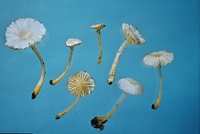
Owner: Herb. PDD | 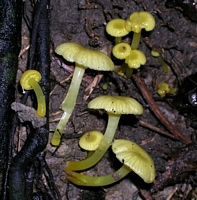
Owner: J.A. Cooper | 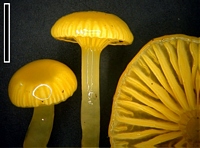
Caption: scale=5mm
Owner: J.A. Cooper | 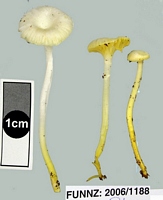
Caption: FUNNZ: 2006/1188, See public note for more information
Owner: FUNNZ | 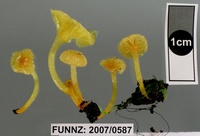
Owner: J.A. Cooper | 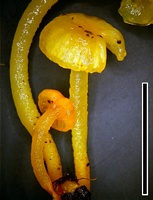
Caption: scale=1cm
Owner: J.A. Cooper | 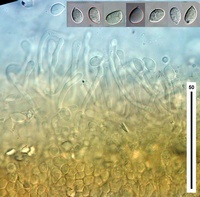
Caption: cheilocystidia and spores
Owner: J.A. Cooper | 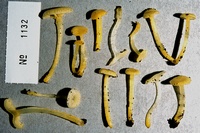
Caption: ZT1132
Owner: E. Horak: © Creative Commons Attribution-Noncommercial 3.0 New Zealand | 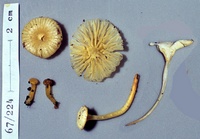
Caption: ZT67-224
Owner: E. Horak: © Creative Commons Attribution-Noncommercial 3.0 New Zealand | 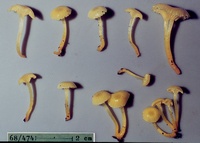
Caption: ZT68-474
Owner: E. Horak: © Creative Commons Attribution-Noncommercial 3.0 New Zealand | 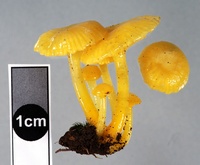
Owner: J.A. Cooper | 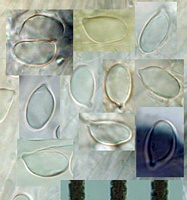
Owner: J.A. Cooper | 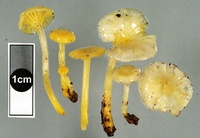
Owner: J.A. Cooper | 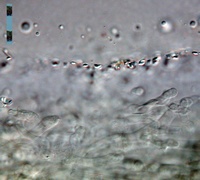
Caption: gill edge showing gelatinous layer with small crystals.
Owner: J.A. Cooper | 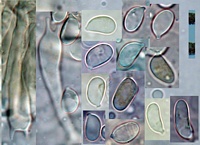
Caption: basidia and spores. bottom right: odd looking elongate spores?
Owner: J.A. Cooper | 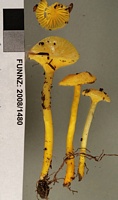
Owner: J.A. Cooper | 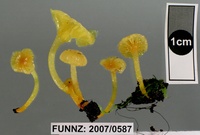
Caption: FUNNZ2007/0587
Owner: FUNNZ | 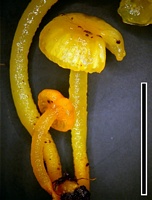
Caption: FUNNZ2007/0587
Owner: FUNNZ | 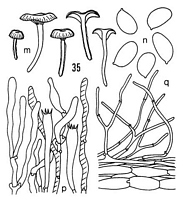
Caption: Gliophorus chromolimoneus (Stev.): m. carpophores. - n. spores. - u. cheilocystidia and basidia. - q. cuticle (Herb. HK. ZT 68/474) | 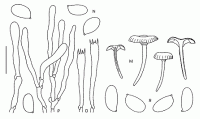
Caption: Fig. 32 Gliophorus chromolimoneus (Stev.) Horak. (M-P: ZT 68/474):
M. basidiomes.N. spores. O. basidia. P. cheilocystidia. (K 1088, type): R. spores. | 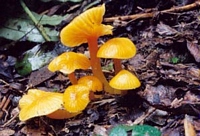
Caption: Gliophorus chromolimoneus
Owner: Kaimai Bush | 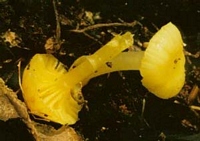
Caption: Gliophorus chromolimoneus
Owner: Kaimai Bush | 
Caption: ZT9582
Owner: E. Horak: © Creative Commons Attribution-Noncommercial 3.0 New Zealand | 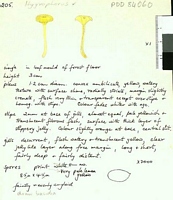
Caption: Watercolour
Owner: G.M. Taylor | 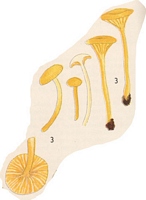 | 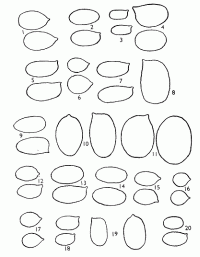
Caption: Spores X 2000 1. Hygrophorus salmonipes 2; H. elsae; 3, H .julietae; 4, H. variabilis; 5, H. lilaceo-lamelllatus; 6, H. muritaiensis; 7, H. keithgeorgei; 8, H. pseudococcineus; 9, H. rubro-carnosus; 10, H. miniceps; 11, H. procerus; 12, H. multic |
Article: Horak, E. (1990). Monograph of the New Zealand Hygrophoraceae (Agaricales). New Zealand Journal of Botany 28(3): 255-306 (http://www.rsnz.org/publish/abstracts.php).
Description: Pileus -30 mm, hemispherical to convex finally umbilicate at centre; yolk-yellow
to lemon-yellow or chrome-yellow, fading to yellowish with age; glutinous, hygrophanous,
striate at margin, membranaceous. - lamellae 8-16 (1 -3) broadly adnate to decurrent
or arcuate; concolorous with pileus fading with age, edges greyish due to gelatinous,
separable thread. - Stipe 20-45 x 2-3 (-4) mm, cylindrical, equal or attenuated
below, occasionally with swollen base; concolorous with pileus, turning orange
at base in aged specimens; very glutinous, hollow, single or caespitose. -Context
yellow, waxy. - Odour and taste not distinctive or slightly unpleasant. - Chemical
reactions on pileus: KOH, HCI - negative.
Spores 6.5-9.5 x 4-5.5 um, ellipsoid. - Basidia 30-55 x 5-7 um, 4-spored. –
Cheilocystidia conspicuous, 30-50 x 2-6 um, with cylindrical to clavate terminal
cells, membrane hyaline, strongly gelatinised, occasionally with yellow plasmatic
pigment. - Pleurocystidia absent. - Pileipellis an ixocutis of suberect, cylindrical
hyphae (2-8 um diam.), membrane strongly gelatinised, with plasmatic pigment;
clamp connections present (Pl. 1, Fig. 6).
Habitat: ECOLOGY: Common; saprobic on soil among litter under Nothofagus (fusca,
menziesii, solandri var. cliffortioides), Kunzea ericoides, Leptospermum scoparium
or in broadleaved-conifer forests (Metrosideros umbellata, Podocarpus hallii,
Dacrydium cupressinum), rarely on rotten wood. December-June.
Distribution: DISTRIBUTION: NZ (NA, N, WL, SL).
Article: Horak, E. (1973). Fungi Agaricini Novazelandiae I-V. Beihefte zur Nova Hedwigia 43: 200 p.
Description: Pileus 5-25 mm diam., hemispherical becoming umbilicate, egg yellow to lemon yellow or chrome yellow, fading to yellowish, glutinous, hygrophanous, striated at the margin, membranaceous. Lamellae broadly adnate to decurrent, concolorous with pileus, fading in age, distant, gill edge darker coloured, gelatinous thread present. Stipe 20-40 x 2-3(4) mm, cylindric, equal or attenuated below concolorous with pileus, but orange at the base, very glutinous throughout its entire length, hollow, single or fasciculate. Context yellow. Taste and odor not distinctive. Chemical reactions on pileus: KOH and HCl- negative.
Spores 7-9.5 x 4-6 µm, ellipsoid, smooth, inamyloid. Basidia 30-47 x 6-7 µm, 4 spored. Cheilocystidia conspicuous, forming a gelatinous thread, terminal elements 30-50 x 2-6 µm, cylindric to clavate, hyaline, membrane strongly gelatinized, occasionally yellow plasmatic pigment present. Pleurocystidia absent. Cuticle a cutis of initially suberect later repent, gelatinized, hyaline hyphae (2-8µm diam.). Clamp connections numerous on cuticular hyphae.
Habitat: On soil under Nothofagus spp. and Leptospermum spp. New Zealand.
Notes: Undoubtedly this species has close relationships to H. octayensis Singer (1962). Both taxa are deep yellow coloured and the pileus and stipe are coated with a glutinous layer; however, the Chilean species is of smaller size and the spores measure about 8.5-10 x 4.5-5.5 µm.
Article: Stevenson, G. (1963) [1962]. The Agaricales of New Zealand: IV. Kew Bulletin 16(3): 373–384.
Description: Pileus 0.5-1.5 cm- diam., lemon chrome, striate at edge, very slimy, hemispherical
to umbilicate; flesh pale yellow. Gills decurrent, yellow, moderately distant,
thick. Stipe 2-4 cm, X 2-4 mm., bright yellow, very slimy, solid or slightly
hollow at base. Spores 9-11 X 5-6 µm, oblong, hyaline, Basidia 30-35 X 5-6 µm,
four-spored.
Habitat: habitat: On mossy banks, Wellington, 12.6.1949, Stevenson; Rotoiti,
16.5.1956, E. Kidson, Otari, 7.6.1958, Stevenson.
Notes: In general appearance this species resembles H. vitellinus Fr. sensu
Bresadola, but the spores are quite different. It is close to H. citrina
var. glutinipes Lange, but has larger spores and lacks orange colour.
|